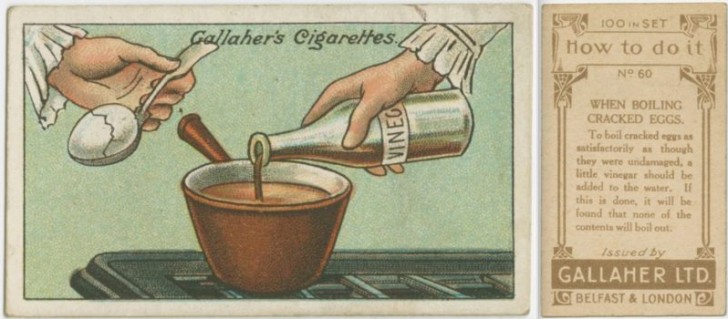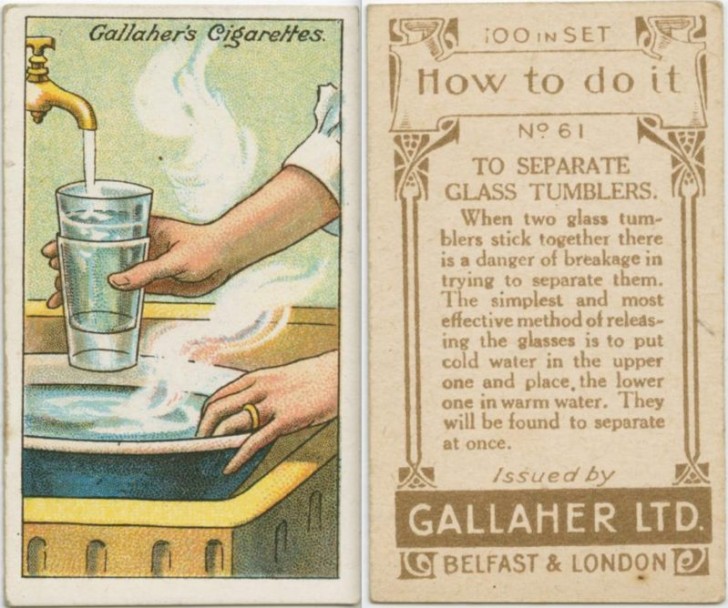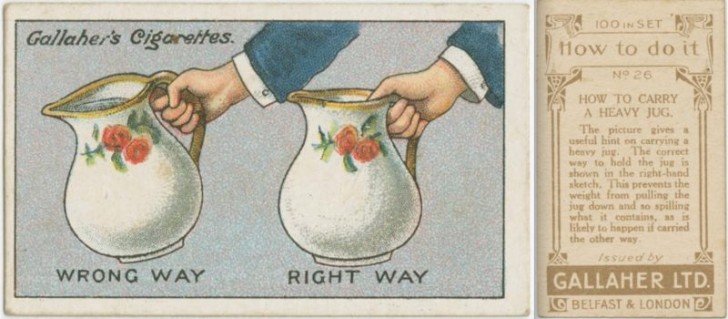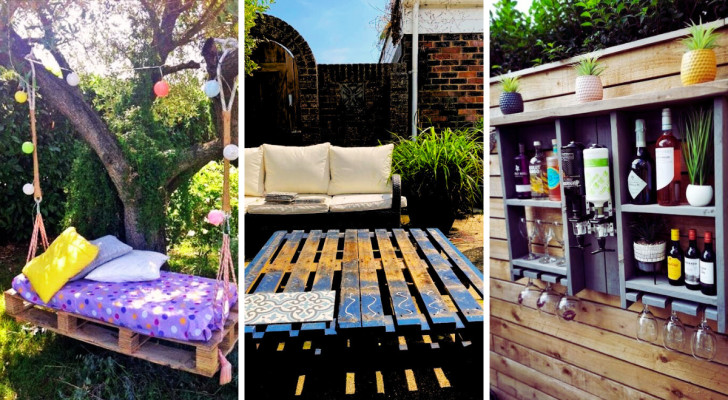16 "grandma" tricks that are over 100 years old that we should keep in mind

We all have some favorite home cleaning tricks, the one that saves us time and money or perhaps presents itself as a more natural and ecological alternative to the methods that use industrial products. However, it might surprise us to discover that this tendency to try do-it-yourself ways to solve many daily problems in order to save time, effort and money has its roots in time.
Even today, in fact, there are several curious tricks that have over 100 years of history. A famous collection of these home tricks is that of the illustrated postcards of the Gallaher cigarette company, known as the Gallaher's Cigarettes cards. The habit of inserting thick postcards to stiffen cigarette packets had begun as early as the 1880s, and soon this little insert had become a collector's item decorated with illustrations, curiosities, images of famous people or attractive women.
In the 1910s the company Gallaher Ltd of Belfast & London together with the Ogden's Branch of the Imperial Tobacco Co began printing the series of postcards "How-To" ("How to do"), full of tricks and tips useful in everyday life, in the context of domestic cleaning and more. These cards are now coveted and highly prized collectibles, even sold for millions of dollars, but many of the advice within them is also really interesting.
In fact, there are tips that nowadays seem at least curious: some present really unlikely situations, such as the trick to stop a running horse, others may now be impractical, such as the correct procedure for saving someone struck by an electric shock; others still make your mouth twist a little, like the trick to treat a "crazy" dog, and there are also several that make us widen our eyes for their danger, like the method for preparing a do-it-yourself fire extinguisher. But among the 100 Gallaher Cards tricks there are also some that are worth reading.
NB: we report the tricks exactly as they were illustrated on the postcards: in case you want to put them into practice, obviously keep in mind that these are very dated advice, and therefore not always impeccable!

- To remove wood splinters from hands (especially from the palm) in a simple and painless way, the postcard suggests filling a glass jar with a wide opening with hot water almost to the brim. Then you have to firmly press the part where the splinter is stuck directly on the opening, closing it completely. It seems that at this point the splinter is pushed out due to the negative pressure and the steam, just enough to easily extract it with tweezers.
- If, on the other hand, you would like to clean the inside of a bottle with a vintage method, it would be enough for you to pour a little sand on the bottom, add water and then shake well, so that the sand works as an abrasive element, cleaning the internal walls. In the end, simply rinse and let the water drain away until the bottle is dry. Nowadays we prefer to use vinegar and baking soda, or maybe salt; or, for vases or objects with a fairly wide opening, we can use a sponge with a magnet inside, to be "controlled" from the outside, but you could also try it with sand!
- Milk was recommended to remove ink stains: the technique consisted of immersing the fabric in a basin of milk, leaving it to soak for a few hours before rinsing and washing thoroughly. There are those who still use this method, even if they now prefer to use denatured alcohol.
- Have you ever had to light matches on a windy day? Well, the trick to do this is to make small incisions on the wooden stem, such as to raise small wooden flakes curving towards the head. Those too will catch fire, and will ensure that the lighter burns even when there is wind.
- Surely many do it, but a hundred years ago it was recommended to separate two glasses stacked together by pouring cold water into the upper one and immersing the bottom of the other in hot water.
- Boiling eggs is very easy, but sometimes cracks form when pouring them into the pot, and then the egg white comes out and is cooked outside the shell. The Gallaher's Cards suggested adding a little vinegar to the boiling water as a solution. Over time, there are those who have tried the variant which consists in rubbing the vinegar on the shell before immersing the eggs in water. These remedies would somehow have the ability to keep the crack in the shell closed, preventing egg white from escaping. Science has not pronounced itself, but adding vinegar to the cooking water actually has an advantage: it makes it easier to shell hard-boiled eggs. In fact, the best way to do it without stress involves adding vinegar to the pot, then, once cooked, immerse them in a bowl with ice and the shell will come off very easily. The reason is perhaps in the fact that the vinegar is able to partially dissolve the calcium carbonate of which the egg shells are composed.
- Still with regard to eggs, the postcards suggested keeping the ones just laid for longer by putting them in a hermetically sealed container full of salt.
- Let's say you bought artisan butter and want to make sure it is of good quality: according to these vintage tricks it would be enough to rub a little on a piece of paper which would then be burned. If the smell emanated is pleasant, then the butter will be pure, if instead you smell an unpleasant smell ("like sebum"), it will be due to the presence of margarine. Nowadays, however, a widely used method is to check how quickly and how a small amount of butter melts when exposed to heat: when it melts quickly and becomes a dark brown it is good, if it becomes only light yellow it will be adulterated.

- When you want to give life to fresh flowers that seem a little withered, try dipping the stems in hot (not boiling) water, leaving them until it has cooled down. Then cut off the lower end of the stem and place them back in the jar. This is due to the fact that hot water (around 40 °) is absorbed faster, as it has fewer air bubbles inside and moves faster than cold water inside the stem, allowing the flower to absorb it more. quickly. Another trick still used by many florists today is to add a little sugar to the water.
- The postcards in question also proposed a useful remedy in case of sprained ankle, which consists in wrapping it well, wetting the bandage and then letting the final flap of the same run up inside a jug full of cold water, positioned more top of the injured ankle. In this way, all the bandage would remain very cold, with the water continuing to slowly descend down the strip of fabric connected to the jug. Nowadays, perhaps using ice is more practical to alleviate the pain caused by this type of wound, but it is certainly important that the sprains are bandaged correctly and firmly, to give the ligaments time to heal avoiding further complications.
- The same type of procedure is also recommended in the Gallaher postcards as an ante litteram automatic irrigation system, to be used when you are away from home: "Fill a large bucket with water and place it a little higher than the plant pots and gather around as many plants as you can. Softly weave two or three strands of wool together, immerse them completely in the water and then place one end in the bucket, holding it steady with a weight on the bottom. Lay the other end on the ground: we recommend using a thread for each pot". It doesn't seem like a foolproof technique, but it would be curious to try it (maybe when we are at home).
- If you like to decorate your house with precious vases, and you want to prevent them from falling and breaking into a thousand pieces, fill them up to a third with sand, so that they remain firmly in place. It's a trick that would certainly help with those that have a small base, and maybe you could use pebbles, marbles or other weights.

- Nowadays, all candlesticks and candle holders have standardized dimensions, so that you can put any candle you want in them, but if by chance you have to reshape a candle that is too large to fit into the chosen support, it would be enough to dip the bottom into pot of boiling water just enough to soften the wax and put it in the candle holder. Without having to heat it, nowadays you could help yourself with a potato peeler.
- When we fill a very large jug and we have to transport it to the table, we all certainly hold it by squeezing the handle, and perhaps helping us with the other hand to support the opposite side or the bottom to prevent the contents from overflowing during transport. But if we only insert the thumb of the hand that holds the handle inside the edge of the jug itself, we would have a much firmer control of the whole operation, and maybe even the other free hand.
- Modern fashion does not make much use of light straw hats, or perhaps the modern models worn in the summer are not made with fully natural fibers. However, if you happen to have to clean a straw hat or some other object made with the same vegetable fiber (for example baskets, chairs, trivets), know that you could remove the stains by rubbing half a lemon on it. "Finish the job with a clean rubber hand carefully rubbed all over the surface, and your hat will be as good as new." In the absence of lemon, try some vinegar or, in severe cases, a little bleach, perhaps diluted, but always be careful to test the remedy on an invisible spot on the object to be cleaned, because it could alter its color.
How about trying any of these brilliant vintage makeups?





